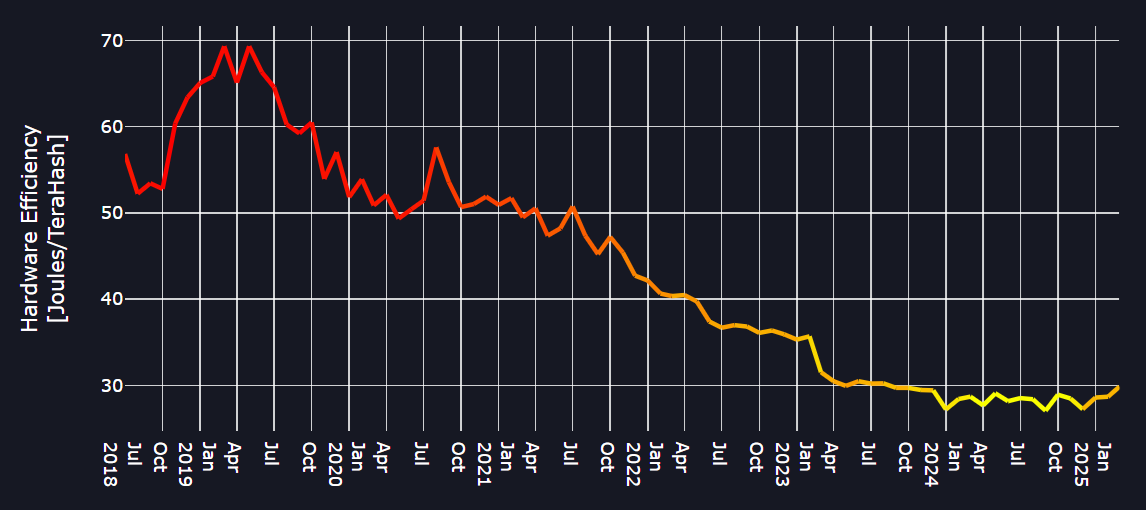While bold Bitcoin price predictions are often front and center in the media, well-reasoned projections about the network’s hashrate—the total computing power securing the Bitcoin blockchain—are much harder to find.
Bitcoin's future price trajectory is shaped by institutional sentiment, macroeconomic trends, and historical valuation models. Projections from leading analysts, asset managers, and investment firms highlight a broad range of potential outcomes.
Some of the most prominent voices in finance have made striking price forecasts: Jurrien Timmer, Fidelity’s Global Head of Macro, suggests Bitcoin could reach $1 billion by 2038. Larry Fink, CEO of BlackRock, sees a path to $700,000. Ark Invest’s Cathie Wood has gone even further, projecting a potential price of $1.5 million by 2030. But what about the underlying infrastructure that supports the network?
Institutional Bitcoin Price Forecasts
In the past five years, Bitcoin’s network hashrate has grown by more than 700%. And in 2025, it's on track to reach a major milestone: 1 Zetahash (1,000 Exahash). Will this remarkable growth continue? What are the forces driving or slowing it down? And where could the network hashrate be by 2030?
What Drives or Limits Hashrate Growth?
Projecting Bitcoin’s network hashrate over the next five years requires more than just extrapolating historical growth patterns. Hashrate is the result of billions of dollars of infrastructure investments, access to energy, and incentives driven by the Bitcoin price. But it is also limited by real-world constraints such as electricity costs, semiconductor supply, and geopolitical risk. These are 7 key factors that will stimulate or impede hashrate growth going forward.
1. ASIC Efficiency and Hashrate Output
One of the primary drivers of network hashrate growth is the ongoing improvement in ASIC (application-specific integrated circuit) miner efficiency. The most advanced models, such as the Antminer S21Xp Hyd and SEALMINER A2 Pro Hyd, are now achieving energy efficiency below 15 joules per terahash (J/TH). However, the current network-wide average is still around 27 J/TH, indicating that there is considerable room for improvement as older machines get replaced. This means that even without an increase in total power consumption, the network’s hashrate could still grow significantly through fleet upgrades.

Bitcoin Network Efficiency Hovering Around 27 J/TH (Source: CoinMetrics)
Moore’s Law is slowing, and Bitcoin mining hardware is hitting physical limits. A decade ago, ASIC miners used 55nm chips, but today’s most advanced models are built on 3nm process nodes. In the early years, each new generation brought dramatic efficiency gains—sometimes 5x to 10x improvements.
Now, those leaps have become incremental. As chips shrink, they face growing challenges: increased heat, reduced reliability, and quantum effects like electron tunneling. Smaller transistors also leave less room for manufacturing error, lowering chip yields and driving up costs. With the end of easy gains from chip design in sight, efficiency improvements will increasingly come from other areas—such as advanced cooling systems, power-tuning firmware, and smarter software for fleet management and uptime optimization.
2. Bitcoin Price Dynamics
The price of Bitcoin remains the single most powerful influence on network hashrate. Since mining revenue is largely driven by block rewards and transaction fees—both denominated in BTC—a rising BTC price boosts profitability. This, in turn, justifies capital expenditure on new machines, facility expansions, and long-term power purchase agreements.
In bull markets, mining becomes attractive to a wider pool of investors. During the 2020–2021 cycle, rising prices triggered an investment frenzy that led to explosive growth in hashrate. On the flip side, bearish market conditions can force operators to delay upgrades, scale down operations, or even shut down entirely. Future price action will have a profound effect on hashrate trajectories. If Bitcoin enters another strong bull market, we could see rapid expansion. But if price stagnates or drops, growth may stall.
3. Government Incentives and Regulatory Clarity
Policy plays a growing role in shaping the global mining landscape. Countries that offer clear legal frameworks, stable contracts, and cheap energy are becoming hubs for new investments. Ethiopia, for example, has recently opened its doors to industrial-scale mining with access to renewable hydropower. The Middle East, especially Oman and the UAE, are also embracing mining as a way to monetize stranded energy and diversify their economies.
In contrast, regulatory crackdowns can rapidly shrink hashrate in entire regions. China’s mining ban in mid-2021 led to the largest hashrate drop in Bitcoin’s history, forcing miners to relocate or shut down. In 2024, Russia's surprise restrictions had a similar—though smaller—impact.
4. Competition for Power Infrastructure
Policy is playing an increasingly important role in shaping the global Bitcoin mining landscape. Countries that provide legal clarity, stable contract terms, and access to affordable energy are emerging as attractive destinations for new investment. Ethiopia has recently opened its market to industrial scale mining powered by renewable hydropower, while countries in the Middle East, such as Oman and the UAE, are embracing mining as a way to monetize stranded energy and diversify their economies.
In contrast, restrictive regulations can quickly disrupt entire regions. China’s mining ban in 2021 triggered the largest decline in Bitcoin hashrate on record, forcing many miners to shut down or relocate. A similar situation unfolded in 2024 when Russia introduced sudden mining restrictions, leading to a significant but smaller impact.
As miners adapt to changing policy and energy conditions, the industry is moving toward greater sustainability. By 2030, more than 70 percent of global mining operations are expected to be powered by renewable sources such as hydro, solar, wind, and geothermal energy. This transition is being driven by cost considerations and growing pressure from investors and governments to meet environmental, social, and governance standards. Increased use of renewables not only strengthens Bitcoin’s sustainability narrative but also improves resilience against rising energy costs and tightening environmental regulations.
5. Semiconductor Supply Chain Constraints
The Bitcoin mining industry is heavily dependent on a complex and constrained semiconductor supply chain. ASIC miners require advanced chip manufacturing, often relying on the same high-efficiency fabrication processes used for AI chips, smartphones, and GPUs. Leading foundries such as TSMC and Samsung operate with limited capacity, and their most advanced production nodes are in constant demand. When demand spikes across industries, these foundries may prioritize customers offering larger volume commitments, better margins, or strategic partnerships. For mining companies, this can result in delayed hardware delivery schedules and increased unit costs.
Geopolitical and economic factors are adding further strain to the supply side. Recently reintroduced tariffs on Chinese semiconductors and mining equipment by the U.S. administration have raised the cost of acquiring new machines and introduced uncertainty around future imports. This may slow down site expansions and reduce near-term hashrate growth.
On a more positive note, TSMC’s planned expansion into U.S.-based chip manufacturing could improve long-term access to mining hardware. Still, the higher labor and operational costs associated with domestic production may limit the extent to which this helps mining companies. As the industry navigates these challenges, supply chain resilience and forward planning will become increasingly critical to sustaining growth.
6. Rising Electricity Costs
Electricity is the largest ongoing expense for Bitcoin miners, and profitability remains highly sensitive to changes in power costs. Even small fluctuations—whether triggered by droughts affecting hydroelectric output, armed conflict damaging infrastructure, rising fuel prices, or currency devaluations—can significantly impact mining margins. To manage these risks, some miners are adopting energy hedging strategies, participating in demand response programs, and diversifying geographically. However, not all operators have the scale or access to implement such tools effectively.
Sustained access to low-cost electricity allows a wider range of hardware to remain profitable and supports continued growth in network hashrate. If power prices rise due to policy shifts or greater demand from energy-intensive sectors like AI and high-performance computing, older or less efficient machines may become uneconomical, slowing the pace of hashrate expansion.
In response, miners are increasingly exploring frontier markets where energy costs are significantly lower. Countries such as Ethiopia, Oman, Paraguay, and Bhutan offer electricity rates as low as 2 to 4 cents per kilowatt hour, thanks to abundant hydro, geothermal, or stranded gas resources. These regions provide a strong economic case for mining, but also come with added challenges—such as the need for enhanced cooling systems in hot climates, heightened security risks, and logistical complexities related to importing equipment and developing infrastructure. While these emerging markets are not yet dominant, they represent a growing share of global hashrate and play a critical role in offsetting rising costs in more mature regions.
7. Diversification Through Compute: Miners Enter the AI Infrastructure Race
The 2024 Bitcoin halving placed significant pressure on miner margins, forcing many operators to reassess their business models. In response, a growing number of mining companies began pivoting into adjacent sectors such as artificial intelligence and high-performance computing. This shift was driven by both economic necessity and the rising demand for AI infrastructure. For example, Core Scientific entered a partnership with AI firm CoreWeave, while companies like Iris Energy and Hut 8 reallocated part of their data center capacity to support AI workloads.
This transition temporarily slowed hashrate growth as resources were diverted away from mining. However, it also strengthened the financial resilience of these firms by opening up new revenue streams that are not tied to block rewards or Bitcoin price cycles. As mining companies increasingly position themselves as diversified infrastructure providers, the line between Bitcoin mining and broader compute services continues to blur.
Growth Trends Recent Years
In the short term, network hashrate projections can be guided by data such as ASIC purchase orders from publicly traded mining companies, import statistics and seasonal patterns—like the impact of extreme weather events on mining operations. However, for longer-term forecasting, these data points become less reliable, and we must turn to historical growth trends to inform projections.
Looking back over the past five years, a clear pattern emerges: since 2021, the nominal hashrate growth has increased year over year. Both 2023 and 2024 were record-breaking, with approximately 250 EH/s and 292 EH/s added to the network, respectively. In percentage terms, the network grew by 94.3% in 2023 and by 56.7% in 2024.
It’s important to note that as the network expands, achieving the same nominal increase results in a smaller percentage gain. For example, adding 100 EH/s to a 200 EH/s network represents a 50% increase, whereas adding the same 100 EH/s to a 700 EH/s network results in only a 14% increase. This natural deceleration in percentage growth is key to understanding how hashrate might evolve over the next five years.

Network hashrate growth over the past 5 years (Source: Digital Mining Solutions).
1-DMA Crosses the Zetahash Mark in April 2025
After a slow first quarter, network hashrate passed the 900 EH/s at the start of April 2025 and reached a high of 929 EH/s on the 7-day moving average (7DMA). That same week, the 1-day moving average (1-DMA) hashrate surged past the 1 Zetahash (ZH) mark for the first time ever. That’s 1 sextillion hashes, or a trillion trillion calculations every second. Despite the 1-DMA being less reliable than the 7- or 30-DMA, this is a monumental achievement showcases the immense computational power securing the Bitcoin blockchain
Network Hashrate by 2030
When projecting Bitcoin hashrate growth, it’s useful to anchor the analysis in recent history. Taking data no further back than the beginning of 2018, when mining started to industrialize and the network was just 14 EH/s, only about 1.7% of its size at the end of 2024. For forward-looking projections, January 1, 2025, is used as the baseline, when the network hashrate stood at 807 EH/s.
Average Nominal Growth
To model the future growth of Bitcoin's network hashrate, one of the most straightforward approaches is to calculate the average nominal growth in exahashes per second (EH/s) on a year-over-year basis.
This method looks at the total increase in hashrate over a specific time period and divides it evenly across the number of years to determine an average annual growth rate. This figure can then be used for simple, linear projections into the future, assuming a steady pace of growth.

Nominal Hashrate Growth Projections.
While this method is easy to calculate, it does not capture the effects of compounding growth or nonlinear adoption patterns.
Adjusted Compound Annual Growth Rate
Given the nonlinear and accelerating nature of Bitcoin mining growth, the best approach to project the next five years is to combine several forecasting methods. Each offers different insights depending on whether growth continues at its historic pace or begins to decelerate as the industry matures.
- Compound Annual Growth Rate (CAGR)
To smooth out the volatility and capture the compounding growth trend from 2020 to 2024, we start by calculating the CAGR. Hashrate grew from 101 EH/s in early 2020 to 807 EH/s at the end of 2024, spanning a five-year period. Using the CAGR formula:
- CAGR = (Ending / Beginning)^(1/n) – 1 = (807 / 101)^(1/5) - 1 ≈ (7.990)^0.2 - 1 ≈ 0.5253 = 52.53%
So, the network’s hashrate grew at an average compounded rate of approximately 52.5% per year over this period.
- S-Curve Framing
While CAGR gives us a solid average, it assumes that growth will continue at the same rate going forward. However, recent data suggests otherwise. Between 2023 and 2024, hashrate experienced an explosive growth from 265 EH/s to 807 EH/s, a 204% increase in just 2 years—a significant acceleration compared to earlier years.
The S-curve is a model often used to describe the typical growth pattern of technologies, industries, or innovations over time. It’s shaped like an “S” because it captures three key stages: early adoption, rapid growth, and maturity or saturation.
The accelerated growth of the past 2 years suggests the bitcoin mining industry is in the rapid growth phase of the S-curve. Question remains how long will this rapid growth persist. While power constraints, site competition and consolidation of big miners suggest that the U.S. is going into the saturation or slowdown phase, other regions like the Middle East, Africa and Latin America just entered the growth phase.
In this context, relying solely on CAGR for forward projections of the global hashrate could lead to overly optimistic estimates.
3. Scenario Modelling: A Tiered Forecast Approach
Rather than betting on a single number, it’s more useful to build out a set of scenarios based on varying assumptions:
- High-growth scenario (CAGR-based): If we apply the historical CAGR of 52.5% going forward network hashrate will be 6,891 EH/s by 2030.
- Moderate-growth scenario (Tapered CAGR): Assuming the industry is maturing, we can use a tapered CAGR of 30% to reflect slowing growth with 2,996 EH/s by 2030.
- Flat-growth scenario (Recent YoY %): If growth continues at the slowest pace seen in the last 5 year, 22.8% annually, network hashrate will be at 2,254 EH/s:

Hashrate Projection — Adjusted Compound Annual Growth Rate.
Conclusion
The CAGR-based projection offers an upper-bound estimate that likely overstates future growth if the industry is indeed transitioning into a slower, more mature phase. A more balanced outlook leans toward a 25% CAGR scenario, which captures continued expansion without assuming exponential gains. Meanwhile, the flat growth model which serves as a conservative benchmark is closed to the optimistic average nominal increase of 271 EH/s.
Forecasting Bitcoin’s network hashrate in 2030 is as uncertain as predicting the asset’s price. Growth will be shaped by a dynamic mix of factors—including hardware economics, technological progress, regulatory shifts, and energy market conditions—making any single forecast an exercise in both data and judgment. As a result, scenario-based planning offers a more practical foundation for stress testing and long-term decision-making.
While Bitcoin’s hashrate is expected to continue rising, the pace will likely be more linear than in previous cycles. The exponential growth of earlier years is giving way to a more mature phase, defined by physical limits on chip efficiency, cost-sensitive deployment, and increased competition for power and semiconductors. The growing overlap between mining and high-performance computing also reflects a more diversified and strategic use of infrastructure. Taken together, these shifts point toward a more resilient and sustainable mining sector—one that will play an increasingly stable role in the digital and energy economies of the next decade.
Note: These projections are based on current data and trends. Actual outcomes may vary due to unforeseen technological advancements, regulatory changes, or market dynamics. Continuous monitoring of these factors is essential for accurate forecasting.
Explore how GoMining Institutional provides access to Bitcoin mining as a yield-bearing strategy, visit institutional.gomining.com
Authored by:
Nico Smid — Research Analyst, GoMining Institutional
Fakhul Miah — Managing Director, GoMining Institutional
May 1, 2025













